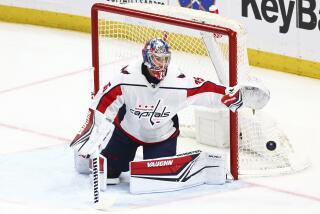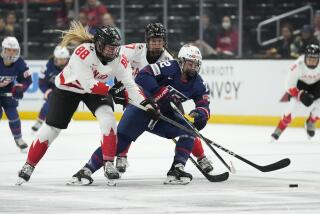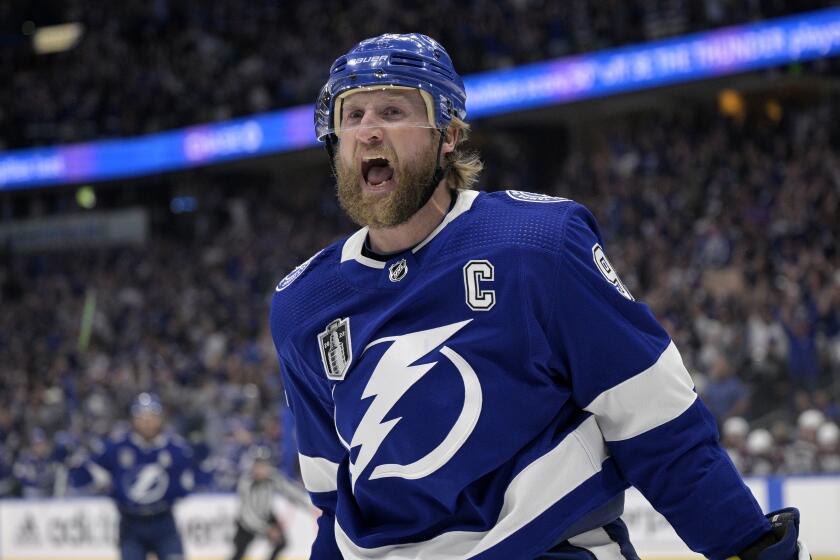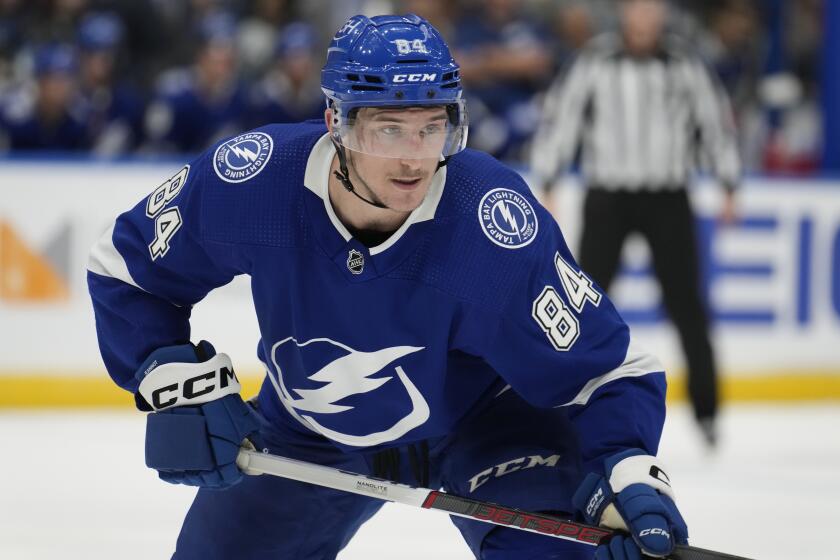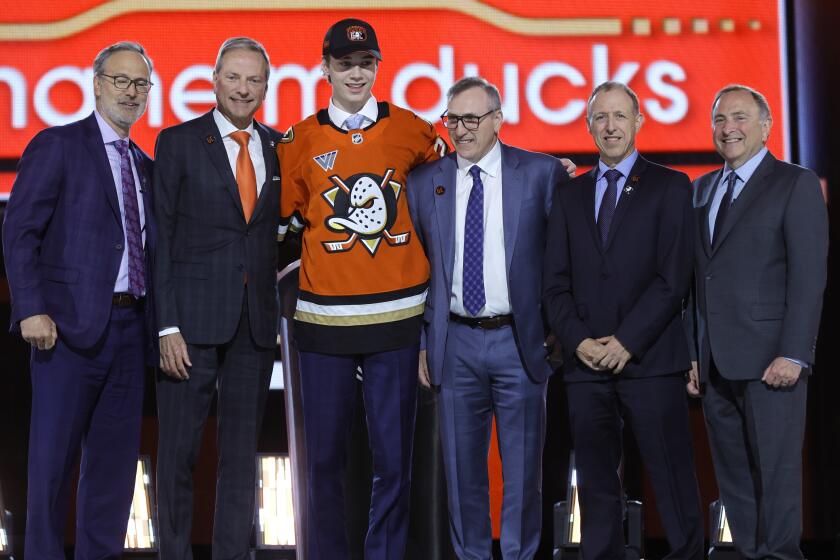MIGHTY DUCKS ‘93-94: PREMIERE SEASON : A Brave new NHL : As It Welcomes Two New Members, the National Hockey League Ponders What It Needs to Do to Become the Sport of the ‘90s
Hockey, sport of the ‘90s?
Al Morganti brought his 4-year-old daughter, Taylor, to about 10 National Hockey League games last winter, and the ESPN hockey analyst said she “absolutely loved” the sport. Taylor then attended her first major league baseball game in August.
“In the fourth inning, she turned to me and said, ‘Daddy, when does the game start?’ ” Morganti said.
Hockey, sport of the ‘90s?
ABC televised five NHL playoff games last spring, averaging a disappointing 1.7 national Nielsen rating in the United States. ESPN televised 64 games in 1992-93, averaging .8 in the regular season and 2.1 in the playoffs.
Pro football, meanwhile, pulled in double-digit ratings, pro basketball was in the 4.5-6.5 range--with playoff games hitting double figures--and some national college football telecasts measured 6.5-7.0 on the Nielsen scale.
“Hockey is overlapped by college and pro football, college and pro basketball and the beginning of baseball season,” NBC’s Bob Costas said. “I think a saturated market place will hold the sport back more than anything else.”
Hockey, sport of the ‘90s?
ABC’s Al Michaels brought his 72-year-old father-in-law to his first NHL game three years ago.
“He looked at me after the first period and said, ‘Where has this been all my life?’ ” Michaels said. “He was like a little kid. He keeps calling me to go to more games.”
Hockey, sport of the ‘90s?
Don Cherry, bombastic host of the popular Hockey Night in Canada telecasts, says hockey will never get a major U.S. television contract, “because people in the South and Midwest would rather watch reruns of ‘The Rifleman’ than hockey.”
Hockey, sport of the ‘90s?
The argument has raged for years. Decades, actually. Back to when hockey was going to be the American sport of the ‘80s. Remember? Two U.S. networks aired hockey in the ‘70s, NHL teams were outdrawing NBA teams in five of eight American two-sport markets, and the U.S. Olympic team’s stunning 1980 gold-medal performance at Lake Placid, N.Y., gave hockey a shot in the arm.
But the NHL lost its network TV contracts in this country and received spotty cable coverage in the ‘80s. Hockey struggled in several markets, and the league did virtually nothing to promote the sport. NHL President John Ziegler was the subject of constant media criticism as an ineffectual caretaker living in the 1950s.
The NBA, meanwhile, brought in David Stern as Commissioner, instituted revenue sharing and salary caps and got back on prime-time television. Magic Johnson, Larry Bird and Michael Jordan helped elevate the NBA into the nation’s preeminent pro sports league, while hockey was pushed to the back of the American fan’s refrigerator, next to the moldy bread.
But last winter, hockey mounted a comeback. Gary Bettman, formerly the No. 3 man in the NBA, took over as NHL commissioner in December and has assembled a more forward-thinking, marketing-conscious staff that Winnipeg Jets General Manager Mike Smith says brought “a breath of fresh air--rephrase that, a hurricane of fresh air,” to the league.
Bettman’s hiring coincided with the announcement that Anaheim and Miami would be granted expansion franchises. Once a regional, cold-weather league, the 26-team NHL now has a more national look in the United States with six Sun Belt teams. It also has unprecedented promotional clout in the Walt Disney Co., which owns the Mighty Ducks, and the Blockbuster Entertainment Corp., which owns the Florida Panthers.
Overall, NHL attendance is on the rise, and the number of youth ice hockey teams has almost doubled in the past 10 years. The popularity of in-line skating and the proliferation of roller-blade hockey leagues--there are some 2,500 in the United States--has made millions more aware of the sport.
Minor league hockey is booming across the country, and retail sales of NHL merchandise, while still well below those of pro football, basketball and baseball, have risen from $50 million in 1988-89 to $800 million last season.
With the addition of ESPN2 (which will not be immediately available in much of Orange County), more than 150 NHL games will be televised this season by ESPN, which is in the second year of a five-year, $80-million contract, and ABC has bumped its NHL commitment from five to six games.
For those bored with baseball, hockey’s warp-speed, non-stop pace, crushing hits and occasional fights quench the thirst for action. But hockey is no longer considered the sport of goons--tougher rules reduced fighting 29% last season, and you’re much more likely to see a bench-clearing brawl at a baseball game.
What’s more, hockey is filled with marketable players who, unlike many pro athletes, don’t seem to have an adversarial relationship with the press or the fans.
“There are many similarities to what I saw in the NBA in the early ‘80s and what I see in the NHL now,” Bettman said. “The NBA then, like the NHL now, was underexposed, underappreciated. I believe we’re poised to go through a boom period, but whether that boom is as big as any other sport’s, I don’t know.”
The road to puck prosperity will have a few bumps. The average NHL salary has doubled (to $467,000 a year) since 1990, while club revenues have been relatively stagnant. Because the league doesn’t have a mega-buck TV contract, teams rely almost exclusively on gate receipts for income. Hence, hockey ticket prices are among the highest in pro sports.
NHL players, who went on strike for the first time two years ago, will start this season without a collective bargaining agreement, and many issues, such as free agency and revenue sharing, need to be resolved.
Hockey purists have always loved the sport, but if the league is to attract more casual fans and broaden its appeal, it must enhance the game on television.
Still, never before have so many factors been working to make hockey the fourth major national sport of the United States.
In the game’s parlance, the puck is loose in the slot, the goalie is down, and all hockey has to do is put it in the net.
But will the goal light flash and the siren blare?
JOB 1: PUSHING PUCKS
Loren Matthews, ESPN’s senior vice president for programming, is a Detroit Red Wing fan, and center Steve Yzerman is his favorite player. “But if he was sitting next to me, I wouldn’t know what he looked like,” Matthews said.
This is one of the NHL’s biggest obstacles. With the exception of the Kings’ Wayne Gretzky and Pittsburgh’s Mario Lemieux, hockey players are not household names and faces across America.
The league hopes to change this with a broad-based marketing plan that includes:
* Establishing a photo library with mug shots of all NHL players to send to broadcast and print media outlets. The other major sports leagues have done this for years. The NHL will do it this season for the first time.
* Working with ESPN to create more up-close-and-personal features on players during hockey telecasts.
* Producing commercials promoting the image and excitement of the game and its players to run on ESPN.
“We need to tell a better story,” Bettman said. “We have to make sure those not familiar with the game have a better chance to understand it, and we have to do more profiles of players. If people knew our players, they’d love them.”
Those who do know the players know they’re the NHL’s biggest untapped resource.
“They seem to have a basic understanding that there’s a relationship between the media and 20,000 people in the arena,” said Steve Dryden, editor of The Hockey News. “Most players are very approachable, good guys. I interviewed Steve Yzerman a few years ago, we had a two-hour lunch, and then he gave me a ride back to my hotel.”
Think Barry Bonds would do that for a reporter?
It’s strange. Hockey players take the same minor league bus rides baseball players do. When they reach the NHL, they’re as revered in Canada as baseball stars are in the United States. But, Dryden said, they seem more friendly and less pretentious than many of their baseball counterparts.
“There’s no reason hockey players should be less stuffy than baseball players,” Dryden said. “Is it just the more money you make, the more corrupt you are? Everyone in Canada knows (Toronto star) Doug Gilmour, and he’s not a jerk here. The fish bowl is smaller, but it’s all relative. Wayne Gretzky is an icon, but even he’s good with the media.”
Gretzky is about as clean-cut as they come, but Dryden thinks teams need to market their offbeat personalities, as well.
“Eric Lindros will be good for the game in the U.S.--he’s a James Dean on skates, a bit of a rebel,” Dryden said. “In some ways, the NHL has been too clean. They haven’t encouraged people to be personalities. For instance, Al Infrate at Washington is an absolute madman, and the Capitals are finally capitalizing with a poster of him on a Harley.”
Hoping to take advantage of the in-line skating craze, the NHL will soon initiate national programs for street and roller hockey. Steve Solomon, NHL senior vice president, said the league will pattern them after San Jose’s Sharks and Parks program, in which the team organizes local leagues and provides equipment.
The program will open in six markets--San Jose, Southern California, Dallas, Miami, St. Louis and Tampa Bay--this year, and the league hopes to have 1 million kids in the program within five years.
“We think these kids can be converted into fans,” Solomon said.
Another conversion--the NHL from a passive to aggressive marketing league--is occurring with the help of Disney and Blockbuster.
“They’re two of the most brilliant marketing companies in the world,” King owner Bruce McNall said. “The league will seek their advice and counsel. Disney and Blockbuster will be very creative, and they’ll throw their resources at the league.”
The Mighty Ducks will likely bring pre-game and between-period entertainment to new levels. Unlike most teams, they’ll use two Zambonis to clean the ice, allowing more show time during intermissions. They’ll have a mascot, dancing cheerleaders and a wandering organist with a remote keyboard.
They’ll require players--it’s in their contracts--to make several public appearances throughout the season. And hot-selling Ducks merchandise is expected to push NHL retail sales over the $1 billion mark this year.
“You’ll see things with us that you probably won’t see with other teams,” said Tony Tavares, Mighty Duck president. “I’m not saying we know better than anyone else, and I don’t want to come across as arrogant. We’re just going to approach this differently.”
And change, according to Alan Friedman, editor of Chicago-based Team Marketing Report, is just what the NHL needs.
“The league should have paid Disney’s and Blockbuster’s franchise fees,” Friedman said. “You’ll see more polished game presentations, more sophisticated packages for advertisers and sponsors. They’ll wake up a lot of teams. There won’t be more of a demand (for hockey) until the product is more visible and better marketed.”
JOB 2: TACKLING TV
Go to two NHL games, Tony Tavares claims, and you’ll be a hockey fan for life. For live sports entertainment, Al Michaels says, nothing beats a hockey game.
Even St. Louis Blues fan Bob Costas, who is not convinced the NHL will grow by leaps and bounds, admits that, as an in-arena experience, hockey is one of the better things in sports.
“But what has hurt hockey more than anything else is it is, to a degree, victimized by its own success from an in-arena aspect,” Michaels said. “The atmosphere at games is spectacular. The sounds of hockey, the skating, the puck hitting wood, the hits. It’s wonderful. It’s the only sport that’s far, far superior there than watching on two dimensions at home.”
Pittsburgh Penguin owner Howard Baldwin says those who know hockey have no trouble following it on television. But Smith, the Winnipeg general manager, acknowledged that, because so many important things happen away from the puck, hockey “is not a great sport for the average fan on TV.”
More ice-level cameras, super-slow-motion replays and goal-net microphones have helped. At the 1993 All-Star game, the league treated the puck with a special paint to make it more visible to the camera but, as Tavares said, “It looked like a blue blur.”
Michaels may have found a solution. He recently bought a 46-inch stereo television and can’t get over how much better hockey games now are on TV.
“A big screen makes a helluva difference,” Michaels said. “Hoover said he wanted to put a chicken in everyone’s pot. Maybe Bettman should put a 46-inch TV in everyone’s home.”
Bettman opted for a more cost-efficient strategy, hiring former NBC producer and college hockey player Glenn Adamo as NHL director of broadcasting. League executives expect Adamo to upgrade the game as a television product, and Disney is expected to provide leadership, as well.
While most teams use four to five cameras to televise games, the Mighty Ducks will use 8 to 10 in Anaheim Arena. They’ll have a remote camera looking down from the base of the scoreboard, and they’re toying with the idea of a sky camera on a cable that can follow a player the length of the ice. They’ll also have a full complement of player profiles.
“You’ll see a lot of innovations,” Tavares said. “I think you’ll like the way we televise games.”
But will people watch? Most league executives think ESPN does an outstanding job, but ratings were low last season. Low ratings make it tougher for TV to sell advertising, which in turn makes it more difficult to attract U.S. national networks.
Many believe a U.S. network contract is essential if the league is to grow. The financial windfall from such a contract would allow teams to keep pace with escalating salary demands and hold ticket prices down, and the additional exposure would enhance the league and broaden its fan base.
And what would convince a network to make a large, long-term commitment to hockey?
“Higher ratings, it’s as simple as that,” said David Downs, ABC’s vice president of programming. “They don’t have to be double-digit ratings, but they have to be higher so we can sell it.”
Downs said ABC was not satisfied with its hockey ratings last spring, “but we saw enough good things behind the scenes in the numbers to tell there’s a future in it,” he said.
Viewer demographics for hockey appear to be very strong. According to Nielsen, 440 of every 1,000 who watched ABC’s first hockey telecast last spring were males ages 18-34, the most targeted marketing audience. NBC’s NHL All-Star game drew a .450 rating in the males 18-34 bracket, the highest among sports shows this year and well above the NBA’s .350 average.
“I don’t have the numbers, but we’re also very strong among women,” Solomon said. “I think this will help us attract more sponsors.”
Bettman views the ratings as a starting point. Because the ESPN and ABC deals weren’t completed until September, the league scrambled to put the schedule together and might have missed some more attractive games.
This season, ESPN will almost triple the number of its NHL telecasts, and games will appear on regular nights. ESPN is available to 63 million homes in the U.S.--a major step up from the 1988-92 SportsChannel contract, which made hockey available to only 15 million homes--and ABC has renewed its small but significant commitment to the league.
“They’re clearly a major step ahead of where they were two years ago, just by virtue of us picking up five games (last season) and renewing it for six games this year,” Downs said. “We see hockey as a sport that’s underexposed on a national level, therefore it has some potential for growth.”
JOB 3: GOIN’ SOUTH
The NHL head office used to be in Montreal. Now it’s in New York. League presidents used to be Canadian. Lately, they’ve been U.S. born. There are more NHL teams in California (three) than in hockey-crazed Quebec (two), and almost as many teams south of St. Louis (seven) as in all of Canada (eight).
Canada’s national pastime is migrating south, and not all Canadians are happily packing their beach towels and sun-tan lotion.
“The Canadian influence (on the game) is definitely slipping,” Cherry said. “Seventy-five percent of the players are from Canada, it’s our religion, and we don’t have much say anymore. A lot of people resent it.”
With growth has come pain for some Canadians, but Bettman hopes to allay their fears.
“We have a great hard-core group of fans, and we’re not going to do anything to alienate them,” he said. “But if we spread the word, we’ll have more fans.”
And why spread the word where the masses have already been converted? When the league, in 1988, adopted a business plan known as “A Vision for the ‘90s,” it decided it must expand to uncharted territories, boldly going where hockey had never gone before.
With the Minnesota North Stars relocating to Dallas this season, and with Florida and California adding teams, the NHL has more of a national look in the United States and can offer sponsors nearly 12 million more potential customers who are part of hockey markets.
“There’s no point in ABC carrying a game nationally if two-thirds of the country doesn’t even see hockey,” McNall said. “We were such a regionalized sport, it was difficult to do a national TV deal.”
Downs, of ABC, said expansion to the South is definitely a plus.
“Advertisers will see this as an opportunity to jump on the bandwagon and get on on its way up,” he said. “You can’t just put a team somewhere and create millions of hockey fans--it has to come with time. But if the product is good enough, and it’s in the right cities, it will grow.”
How far? Many believe Phoenix will be the next NHL city. Houston and San Diego have been mentioned as strong expansion candidates. What about Stockholm? Helsinki? Baldwin, the Pittsburgh owner, doesn’t think that’s far-fetched.
“As the league stabilizes, I would hope we’d have a strong presence in Europe,” Baldwin said. “Europeans play hockey as well as, or better, than we do. There are great players and great markets in Finland, Sweden, Czechoslovakia, and we even own a team in Russia. I would hope, by the end of the 1990s, we were there.”
THAT’S HOCKEY
The Columbus Chill set a minor league record last season with 39 consecutive sellouts in the 5,700-seat Ohio State Fairgrounds Coliseum. The Hampton Roads Admirals averaged 8,500 a game in the 8,900-seat Norfolk (Va.) Scope.
The Chill and Admirals are in the East Coast Hockey League, one of the lowest levels of minor league hockey in the United States, the bush leagues.
“It’s bad hockey, but when you strip it down, it’s a very entertaining game,” Morganti said.
This is hockey’s biggest attraction: The game itself.
It combines the speed and grace of basketball without the free throws, the ferocity of football without the huddles, the punch of boxing without Don King. For those tired of the national pastime, it’s pretty much the anti-baseball.
“If you tried to sell baseball to a younger audience without all the tradition, you’d say, ‘Let’s watch a game where guys stand around, the defense controls the ball and there’s no contact.’ They wouldn’t want that,” Morganti said.
“In hockey, you have collisions all the time, it’s fast-paced, guys play with knives on their feet and sticks in their hands, you’re always on the edge of your seat, it’s controlled mayhem at times . . . I would think that would appeal.”
These elements have helped hockey survive--and thrive in many areas--for 76 years despite some poor management. Now, the league office is filled with progressive minds, people who are perceived to be more competent and are expected to take the NHL to another level.
“Hockey could be the sport of the ‘90s because it has the furthest to grow,” Dryden said. “The question is whether they can capitalize on this opportunity. You can’t manufacture interest--you can pique it and then see if it’s genuine. But these guys will do enough things right to give it a fair chance.”
By the Numbers
Average Ticket Prices NFL: $28.68 NHL: $26.00 NBA: $25.16 ML Baseball: $9.57
USA Hockey Amateur Team Registration Year: Teams* 1968-69: 3,802 1973-74: 10,298 1978-79: 10,933 1983-84: 11,543 1988-89: 15,206 1992-93: 18,637
NHL Average Salaries 1983-84: $134,000 1984-85: $149,000 1985-86: $159,000 1986-87: $173,000 1987-88: $184,000 1988-89: $201,000 1989-90: $232,000 1990-91: $276,000 1991-92: $368,000 1992-93: $467,000
NHL Retail Merchandise Sales 1988-89: $50 million 1989-90: $200 million 1990-91: $350 million 1991-92: $600 million 1992-93: $800 million
Other Sports’ Retail Merchandise Sales NFL, 1992: $2.5 billion ML Baseball, 1992: $2.5 billion NBA, 1992-93: $2.2 billion
* -- 14.25 players per team
Sources: Team Marketing Report, National Hockey League) Building the NHL
The National Hockey League is more than four times bigger than when the modern expansion era began in 1967. A look at when franchises were added.
THE ORIGINAL SIX Montreal Canadiens Toronto Maple Leafs Boston Bruins Chicago Blackhawks Detroit Red Wings New York Rangers
1967 Los Angeles Kings Dallas Stars (1) Philadelphia Flyers Pittsburgh Penguins St. Louis Blues California Golden Seals (2)
1970 Buffalo Sabres Vancouver Canucks
1972 Calgary Flames (3) New York Islanders
1974 New Jersey Devils (4) Washington Capitals
1979 (Absorbing World Hockey Assn. teams) Edmonton Oilers Hartford Whalers Quebec Nordiques Winnipeg Jets
1991 San Jose Shards
1992 Ottawa Senators Tampa Bay Lightning
1993 Anaheim Mighty Ducks Florida Panthers
1-Joined league as Minnesota North Stars
2-Later folded and merged with North Stars
3-Began in Atlanta
4-Began as Kansas City Scouts; became Colorado Rockies before moving to New Jersey
Source: National Hockey league
More to Read
Go beyond the scoreboard
Get the latest on L.A.'s teams in the daily Sports Report newsletter.
You may occasionally receive promotional content from the Los Angeles Times.
